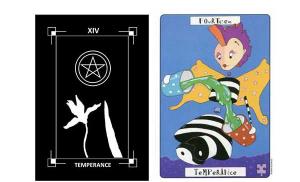Why is the St. George ribbon a symbol? St. George's ribbon: what it symbolizes and how to wear it correctly
St. George Ribbon- bicolor (two-color) orange and black. It traces its history from the ribbon to the soldier's Order of St. George the Victorious, established on November 26, 1769 by the Empress Catherine II. This tape with minor changes entered the USSR award system as the “Guards Ribbon” - a sign of special distinction for a soldier. The block of the very honorable “soldier’s” Order of Glory is covered with it.
The black color of the ribbon means smoke, and the orange color means flame. St. George ribbons occupy the most honorable place among the numerous collective awards (distinctions) of units of the Russian army.
The Order of George was established in 1769. According to its status, it was given only for specific feats in war time"those who... distinguished themselves by some special courageous act or acted wisely for our military service useful tips". It was an exceptional military award. Order of St. George was divided into four classes. The first degree of the order had three signs: a cross, a star and a ribbon consisting of three black and two orange stripes, which was worn over the right shoulder under the uniform. The second degree of the order also had a star and a large cross, which was worn around the neck on a narrower ribbon. The third degree is a small cross on the neck, the fourth is a small cross in the buttonhole.
The black and orange colors of the St. George Ribbon have become a symbol of military valor and glory in Russia. There are different opinions about the symbolism of the St. George ribbon. For example, Count Litta wrote in 1833: “the immortal legislator who founded this order believed that its ribbon connects the color of gunpowder and the color of fire...”. However Serge Andolenko, Russian officer who later became a general French army and made up the most complete collection drawings and descriptions of regimental badges of the Russian Army, I do not agree with this explanation: “In reality, the colors of the order have been state colors since the time when a double-headed eagle on a golden background became the Russian national emblem... This is how the Russian coat of arms was described under Catherine II: “Black eagle, on the heads there is a crown, and at the top in the middle there is a large Imperial crown - gold, in the middle of the same eagle George, on a white horse, defeating the serpent, the epancha and the spear are yellow, the crown is yellow, the serpent is black." Thus, the Russian military order and had its name and its colors deep roots in national history."
The St. George ribbon was also assigned to some insignia awarded to military units - St. George's silver trumpets, banners, standards, etc. many military awards were worn on the St. George ribbon, or it formed part of the ribbon.
In 1806, the award St. George banners were introduced into the Russian army. At the top of the banner was placed the St. George's Cross; under the top was tied a black and orange St. George's ribbon with banner tassels 1 inch wide (4.44 cm). In 1855, during Crimean War, lanyards of St. George's colors appeared on officer's award weapons. Golden weapons as a type of award were no less honorable for a Russian officer than the Order of George.
After the end of the Russian-Turkish war (1877 - 1878), the emperor Alexander II ordered the commander-in-chief of the Danube and Caucasian armies to prepare presentations for awarding the most distinguished units and units. Information from commanders about the feats performed by their units was collected and submitted to the Cavalry Duma of the Order of St. George. The Duma report, in particular, said that the most brilliant feats during the war were performed by the Nizhny Novgorod and Seversky dragoon regiments, which already have all the established awards: St. George's standards, St. George's trumpets, double buttonholes "for military distinction"on the uniforms of headquarters and chief officers, St. George's buttonholes on the uniforms of lower ranks, insignia on headdresses. A personal decree was established on April 11, 1878 new sign differences, the description of which was announced by order of the Military Department dated October 31 of the same year. The decree, in particular, said: “The Sovereign Emperor, bearing in mind that some regiments already have all the insignia established as a reward for military exploits, has deigned to establish a new highest insignia: St. George ribbons on banners and standards with inscriptions of insignia for which the ribbons granted, according to the attached description and drawing. These ribbons, being part of the banners and standards, are under no circumstances removed from them.”
Until the end of the Russian existence imperial army this award with wide St. George ribbons remained the only one. During the Great Patriotic War, continuing the military traditions of the Russian army, on November 8, 1943, the Order of Glory of three degrees was established. Its statute, as well as the yellow and black coloring of the ribbon, were reminiscent of the St. George Cross. Then the St. George ribbon, confirming traditional colors Russian military valor, adorned many soldier and modern Russian award medals and badges.
March 2, 1992 By Decree of the Presidium of the Supreme Soviet of the RSFSR "On State Awards Russian Federation“It was decided to restore the Russian military Order of St. George and the insignia “George Cross.” The Decree of the President of the Russian Federation of March 2, 1994 states: “The military order of St. George and the insignia “George Cross” are preserved in the system of state awards.
St. George's ribbon today
In our time, an interesting tradition has emerged associated with this ancient symbol. Young people, on the eve of the Victory Day holiday, tie a St. George's flower on their clothes as a sign of respect, memory and solidarity with the heroic Russian soldiers who defended the freedom of our country in the distant 40s.
The campaign was invented for the 60th anniversary of the Victory Natalya Loseva- employee news agency"RIA News". The organizers of the action are RIA Novosti and the Student Community. Funding for the purchase of ribbons is provided by regional and local authorities. The promotion is supported by the average and big business, various media.
The action begins with volunteers distributing among the population small pieces of ribbons identical in shape and color to the St. George Ribbon. According to the terms of the promotion, the ribbon must be attached to the lapel of clothing, tied on a hand, on a bag or on a car antenna. The purpose of this event is “to create a symbol of the holiday”, “to express our respect for veterans, tribute to the memory of those who fell on the battlefield, gratitude to the people who gave everything for the front.”
The scale of the action is quite large, both territorial and financial. In 2005, 800 thousand ribbons were distributed; 1.2 million ribbons were distributed in 2006; In 2007, approximately 10 million tapes were distributed worldwide.
However, not all Russian residents support the action. In 2008, the website za-lentu.ru was created, which advocates the St. George Ribbon and considers the action extremely disrespectful towards the symbol of Victory. First of all, opponents of the action are outraged by the use of tape for commercial purposes, disrespectful tying it to clothes, bags and even pets. Participants in the action are considered by some media representatives as fascists or people who do not respect or value WWII veterans.
Hello my dear readers. The celebration of Victory Day is just around the corner. Numerous residents of the country will hang St. George ribbons not only on their chests, but also on bags, cars, and even weave them into their hair instead of ribbons. Do you know what the St. George ribbon means? Where did it come from, the designation of stripes and colors? This is what I want to tell you about today.
How did the St. George ribbon appear?
The history of its appearance begins in the 18th century. National colors Russian Empire considered white, orange (yellow), black. The country's coat of arms was decorated with these shades. On November 26, 1769, Catherine II established the Order of St. George the Victorious. It included a ribbon called “St. George” in honor of this order, which was awarded to generals and officers for military merit.
In 1807, another medal was approved - a badge of merit of the Military Order. This award was also dedicated to St. George the Victorious. Unofficial name- St. George's Cross. Since 1913, non-commissioned officers and soldiers were awarded the St. George Medal.
All these awards were received along with the St. George's Ribbon. If for some reason the gentleman was not awarded the order, he received the St. George Ribbon.
At the beginning of the 19th century, the St. George standards appeared. After the Marine Guards crew received this award in 1813, the sailors began wearing the St. George ribbon on their hats. For the differences, the tapes were rewarded whole military units by decree of Emperor Alexander II.
After the October Revolution of 1917, all tsarist medals were abolished by the Bolsheviks. But even after that, they were awarded with a ribbon for their merits.
In the post-revolutionary period, the most respected insignia were “For the Great Siberian Campaign” and “For the Ice Campaign.” These awards included St. George's ribbons.
What do the colors and stripes mean?
According to the statute, the St. George Ribbon had two stripes of yellow and three stripes of black. Although immediately instead of a yellow tint, orange was used.
Even Catherine the Great, when establishing the colors of the ribbon, relied on the meaning of yellow as a sign of fire, and black as a symbol of gunpowder. The black color is also interpreted as smoke, but this does not change the essence. Therefore, flames and smoke represent military glory and soldier's valor.
There is another version. I have already said that we chose this color scheme in particular (gold, black), just like the coat of arms of Russia.
In heraldry, it is customary to symbolize the black shade with mourning, earth, sadness, peace, death. The golden hue symbolizes strength, justice, respect, power. Therefore, the color scheme of the St. George Ribbon combines respect for the heroes and participants in the battle, regret for its victims, glorification of the courage and strength of the fighters, at the cost of whose lives justice was restored.
Another version says that color symbolism These shades are associated with the face of St. George the Victorious, where he defeats the snake.
There is also a consideration that the stripes on the St. George Ribbon represent the death and return to life of St. George the Victorious. He faced death three times and was resurrected twice.
It should be noted that the designation of colors is still debated to this day.

Symbol
The St. George Ribbon became a symbol of Victory on May 9, 1945. By a decree of the Presidium of the USSR Armed Forces on this date, the medal “For the victory over Germany in the Great Patriotic War of 1941-1945” was introduced. It is this ribbon that covers the medal block.
The medal was awarded not only for special merits, but also to all participants in hostilities. This honor was given even to those who left the service due to injury and were transferred to another job.
The approximate number of recipients is around 15 million people.
The Order of Glory was awarded only for personal merit. Commanders, home front workers, and developers of military equipment were not given such an honor. The medal was awarded only to ordinary soldiers based on the statute of the order:
- Personal capture of a German officer.
- Personal destruction of a mortar or machine gun at an enemy position.
- Capturing the enemy's banner while ignoring one's own safety.
- Carrying out a military mission from tank weapons while being in a burning tank.
- Providing assistance to the wounded in a number of battles under enemy fire at the risk of life.
- Destruction of a bunker garrison (trench, bunker, dugout) regardless of the danger.
- Removal or capture of an enemy patrol (post, secret) at night.
- Destruction of an enemy warehouse with military equipment during a night raid.
- Saving the banner in a moment of danger from being captured by the enemy.
- Creating a passage through an enemy wire fence during combat operations.
- When a wounded soldier returns to the battlefield.
As you can see, my dear readers, the order was awarded to those who daily put their lives in danger and really tried to do everything in the name of a great victory.

How to wear the ribbon
The ribbon was worn in different ways. Everything depended on the class of the gentleman. There were three possible options:
- On the neck.
- In the buttonhole.
- Over shoulder.
Can you imagine how proud the owners of this award were? Also interesting is the fact that the warriors who received this award also received a lifetime reward from the treasury. After the death of the recipients, the ribbon passed to their heirs. But the award could be deprived if any act was committed that tarnished the reputation of the Knight of St. George.
St. George's ribbon today
Every year on May 9, we see this ribbon on many people as a sign of respect for fallen war heroes. This action originated in 2005. Its creator is Natalya Loseva, who works at RIA Novosti. This agency, in tandem with the ROOSPPM “Student Community”, are the organizers of the action. It is financed by local and regional authorities, supported by the media and businessmen. Volunteers hand out ribbons to everyone.
The purpose of the holiday is to express respect and gratitude to veterans who died on the battlefield. When we wear the St. George Ribbon, it means that we remember the Second World War and are proud of our valiant ancestors. The ribbon is distributed free of charge. Most often we see and wear it during the celebration of Victory Day.
As you can see, dear readers of my blog, the history and significance of the St. George Ribbon are still important today. Do you wear this Victory sign during the holiday? Share the article with your friends. And, of course, don’t forget to subscribe to blog updates.
Sincerely, Ekaterina Bogdanova
The history of the St. George ribbon is inextricably linked with the heroic past of Russia. It is known that it was an integral part of three award signs established in the name of the patron saint of the Russian army, St. George the Victorious - an order, a cross and a medal. In addition, the ribbon adorned the visor caps of sailors who served as part of the Imperial Guards crew and on ships awarded the St. George flag. It also flew on the banners of the royal army.
What does the St. George Ribbon mean? The history of its appearance
During the military campaign of 1768-1774, a special award was established - the St. George Ribbon - to reward those who showed courage, bravery and prudence for the benefit of Russia. Her motto became the following words: “For service and courage.” A corresponding award sign also appeared - a white equilateral cross or a four-pointed gold star.
There are four known degrees of the order. Cavaliers were the first to be awarded a cross, a star and a ribbon decorated with stripes of black and orange. Heroes awarded the order of the second degree also had a star and a separate cross, which they wore around their necks. The next degree gave the right to wear a small cross around the neck, and the fourth - in the buttonhole. Since the establishment of the order, black and yellow colors have become symbols of military valor and courage. Thus, the history of the appearance of the St. George Ribbon can only be considered in conjunction with the history of the order itself.
What the ribbon looked like and how it was put on

The ribbon was worn depending on the class of the recipient. There were three options: in the buttonhole, around the neck or over the shoulder. The history of the St. George Ribbon also includes the following curious fact: those awarded it received a lifelong salary from the treasury, and after their death, the heirs became the owners of the award. But the order’s statute also provided for the deprivation of awards to those who, by any unseemly act, tarnished the honor of the Knight of St. George.
Initially, the St. George Ribbon was made of silk and decorated with stripes of black and yellow flowers- this was provided for in the order’s statute of 1769. But if you look at the samples of those ancient years that have come down to us, you will notice that even then the yellow color on them clearly gravitated towards orange, which would be officially approved only in 1913. For a long time, there have been discussions about what the St. George Ribbon means.
The history of its appearance is connected with war, so many believe that black means smoke, and orange means flame. This version, of course, has a right to exist, but the one expressed by the famous expert in the field of phaleristics S. Andolenko is more likely. He draws attention to the correspondence between the colors of the ribbon and the state emblem of Russia - a black eagle on a golden background.
St. George Ribbon. History, meaning and features
There are many order ribbons, but only a few of them have independent status. The history of the St. George Ribbon knows periods when it was used as a full-fledged analogue of an order or a cross. For example, during the Crimean War, the defenders of Sevastopol could not receive awards and were given ribbons. Another example is the period of the Imperialist War, when those awarded the order pinned a ribbon to the side of their overcoat. But there is also a known case when the St. George Ribbon was awarded without an order and had an independent meaning.

This happened in 1914. One of senior officials General Staff was awarded it for being able to the shortest possible time mobilize the army. Neither the order nor the cross could be awarded, since they were awarded only to participants in hostilities. The ribbon was granted to him in addition to the previously existing order, and thus the general received the right to wear it on the St. George ribbon, which was a unique case in the history of Russia.
Two types of tapes
During the reign of Emperor Alexander I, it became a tradition to award units that particularly distinguished themselves in military operations with St. George's Banners. These award standards differed from others in that they upper parts(on the tops) the St. George Cross was placed, and a black and gold ribbon with banner tassels was attached under it. There were no inscriptions on it. Over time, they began to be called “narrow St. George ribbons.”
In contrast, by imperial decree of 1878, wide ribbons were introduced, on which it was written for what specific merits military unit received this award banner. Such a ribbon became an integral part of the standard and was not removed from it under any circumstances. Their story begins with the fact that at the end of the military campaign of 1877-1878, Alexander II wished to reward the most distinguished units and units of the Danube and Caucasian armies that took part in the battles.
Unique awards for combat regiments
The army commanders presented information about the two regiments that fought under their command. Attached to the report detailed list their exploits. But when the relevant commission began to consider the issue of awards, it turned out that these regiments already had all the awards that existed at that time. It was for them that a wide St. George ribbon was established with a listing of their merits.

No more similar ribbons were awarded, and these two regiments forever remained the only ones to receive this honor. It is known that at the end of the Crimean War, by decree of the emperor, personal award weapon, decorated with lanyards in the colors of the St. George ribbon. Such an award was considered no less honorable than an order. Examples of these golden weapons can be seen today in many museums across the country.
The palace hall dedicated to the holders of the order
In St. Petersburg at the royal residence in late XVIII century, the Great Throne Hall was opened. Its consecration took place on November 26, the day of the celebration of the memory of St. George the Victorious. In this regard, it was named after him. Since then, all protocol events related to awards have been held within its walls. A commission that considered the candidacies of the next gentlemen also met there, and receptions were held annually in honor of his gentlemen.
Rewarding with a ribbon in the White Guard troops
After seizing power in 1917, the Bolsheviks abolished the previous award system, and the black and gold ribbon began to be used only in units of the White Army. An example is its presentation together with the badge “For the Ice March”, which was used in the award system of Kornilov’s Volunteer Army. Also on the Eastern Front, it was attached to the medal “For the Great Siberian Campaign”.

In addition, the history of the St. George Ribbon contains many facts of its use as patriotic symbols by many White Guard units and formations. Ribbons with black and orange stripes decorated the banners, chevrons and headdresses of soldiers and commanders. This was especially true for participants in the Yaroslavl uprising. The famous ataman Annenkov obliged veterans of his movement to wear St. George's ribbons to distinguish them from recently recruited fighters.
Allies of enemies and fighters against Bolshevism
In 1943, the German command formed the so-called Russian Corps, consisting of immigrants and former citizens USSR, who went over to the enemy's side. It was used to suppress the resistance of Yugoslav partisans, and its most distinguished members were awarded St. George's crosses and ribbons. Unfortunately, the history of the St. George ribbon contains not only heroic pages. Vlasovites who fought in the ranks of the Wehrmacht also often wore this badge of valor on their chests.

In 1944, a collaborationist organization called the Union of Struggle against Bolshevism was created in Bobruisk. On his banner, decorated with two-color ribbons, was an image of the Cross of St. George embroidered in silver. The same tapes served armbands and the distinctive signs of its leaders. Among the numerous unions created in the West by Russian immigrants, all kinds of symbols, including the St. George Ribbon, were popular. One of such organizations was the Russian All-Military Union.
Continuation of the patriotic tradition
The St. George ribbon, the history of which is closely connected with the heroic pages of the Russian-Turkish war, eventually became part of the symbolism and Soviet army. In 1942, at the height of the battles against fascism, the Guards Ribbon was established, corresponding in appearance to the well-known St. George ribbon. This was a continuation of the glorious patriotic tradition.
It was used on Red Navy visors and as a design for the “Naval Guard” breastplate. The banners of guards units, formations and ships were decorated with the image of a ribbon. In 1943, by government decree, the ribbon of the Order of Glory was established. to his appearance it is completely identical to Georgievskaya. It was also used to decorate the block of the medal “For Victory over Germany.”
Revival of glorious awards
With the advent of democratic changes in the country, the attitude towards the monuments of our history has changed in many ways. By government decree of March 2, 1992, the Order of St. George and the insignia “St. George's Cross” were restored. In 2005, in honor of the sixtieth anniversary of the victory over fascism, a public event called “ George Ribbon" Its initiators were the RIA Novosti agency and the Student Community.

From that time on, the Guards Ribbon began to be called St. George's Ribbon again, and events dedicated to it became annual. Thousands of activists are distributing ribbons these days to everyone who wants to express their gratitude to our veterans in this way. Black and gold ribbons symbolizing courage and heroism Russian soldiers, are attached to clothing, bags and car antennas. The action is held under the motto “I remember, I am proud.” Thus, the history of the St. George ribbon, briefly outlined in this article, was continued.
It seems that not so long ago the St. George’s ribbon became an attribute of Victory Day. Meanwhile, twelve years have passed. Let us remember that the tradition was started by Moscow journalists and was picked up almost immediately throughout the country, as well as beyond its borders. They picked it up so quickly because the symbol has a long and glorious history. And Alexander Semenenko, candidate of historical sciences, reminded us of it on the eve of the next Victory Day.
The St. George Ribbon is a memory of the two-color ribbon for the Order of St. George, the St. George Cross and the St. George Medal. The award came at the height of Russian-Turkish War, when Empress Catherine II established the order in honor of St. George the Victorious. “George the Victorious is considered the patron saint of the Russian army. In addition, he is depicted as a patron on the coat of arms of Moscow. And then such a long-standing tradition developed that St. George the Victorious is, first of all, a man, and then a symbol of the inflexibility of the Russian spirit. The introduction of such an order was supposed to contribute to the rise of soldiers,” says our interlocutor.
The order, as he notes, has a heraldic component attached to it, and it found its origins in existing symbols: “Black is the symbol of the eagle, and the eagle is the coat of arms of the Russian Empire. The orange field was initially yellow. I would like to note that orange and yellow are considered a type of golden field. This is the field of the Russian state emblem."

Here true meaning ribbon colors. But today we often hear that gamma means smoke and flame. As an option - gunpowder and flame. It sounds nice, but it's not true. And it also has a long history. In the nineteenth century, as some sources note, some nobles wrote that “the immortal legislator who founded this order believed that its ribbon connected the color of gunpowder and the color of fire.”
“The common belief that orange symbolizes fire, and black symbolizes ash or smoke, is fundamentally wrong,” says Alexander Mikhailovich. - There is classical heraldry. Such comparisons are beyond the bounds of science. The St. George ribbon is a historical image and it is better to work with explanations of classical heraldry, rather than invent something. I propose to agree with the arguments of Catherine II. Black is the heraldic color of the eagle. The double-headed eagle is now both the Coat of Arms of the Russian Federation and the Coat of Arms of the Russian Empire, which we borrowed during the era of the Grand Duke of Moscow Ivan III, thanks also to his second wife Zoya, or Sophia Paleologus. And yellow or Orange color, as we said, is a kind of heraldic understanding of the golden color around the state coat of arms. George the Victorious himself became a kind of symbol of Russia. Although it is worth noting that George is close to both Muslims and some other religions, so representatives of different faiths are happy to come to our Victory Square to pay tribute to those who fought for the freedom of our Motherland.”
The image of the St. George ribbon was dear to the people and Soviet time. During the Great Patriotic War, it became clear that it was necessary to revive national heraldic traditions. “And when the guard was born in the battle of Moscow, guards ribbons appeared, they were slightly modified, but they were based on the St. George component. Then the Order of Glory appears for soldiers and sergeants, there, too, on the order block we see the St. George ribbon. So when Soviet Union won the war, a medal “For Victory over Germany” appeared, and the St. George’s ribbon is also depicted on the order block. And if we look at the anniversary medals of our veterans, the St. George format is reproduced everywhere,” explains the historian.

The chain of times, according to the interlocutor, closed when in 2005, at the celebration of the next anniversary Great Victory people wanted to find some symbol that was not invented, but took into account Russian traditions, and Soviet and would be understandable to modern youth. “The St. George’s ribbon became such a symbol. She gained popularity very quickly. Twelve years have passed, and it has become clear that this is a successful designation of the holiday and involvement in it. And, of course, this is a kind of belonging to the Russian world, a sign that you remember the victories of your ancestors, and these are Nevsky, Kutuzov, Bagration, Zhukov, Vasilevsky,” says Alexander Semenenko.
As we can see, we didn’t have to invent anything in order to get a bright symbol of the great holiday that was close to millions. “You just need to comprehend the traditions and carefully try to recreate everything. If it had been superficial, artificially imposed, it would probably have been rejected. The ribbon continues to live, and it continues to unite us all - the fallen, the living, and those who will come after us,” the interlocutor concludes.
Black and yellow and they reproduce the colors of the state emblem under Catherine II: a black double-headed eagle on a golden background. The image of George both on the state emblem and on the cross (award) itself had the same colors: on a white horse, white George in a yellow cloak, killing a black snake with a spear, respectively, white cross with yellow and black ribbon. This is the true meaning of ribbon colors. But today we often hear that gamma means smoke and flame. As an option - gunpowder and flame. It sounds nice, but it's not true.
We all know that the “St. George Ribbon” is an all-Russian event for the distribution of symbolic black and orange ribbons signifying Victory in the Great Patriotic War. The Code of the Action states that the St. George Ribbon symbolizes respect for war veterans, tribute to those who died, and gratitude to those who gave everything for victory in the war. Ribbons, as a symbol of the unbroken spirit of the people who defeated fascism, began to be distributed in 2005 on the initiative of the Student Community and RIA Novosti. However, few people know why this ribbon is black and orange, and also what exactly these colors mean.
In fact, the name of the action refers us to the St. George Ribbon. This is the name of the two-color ribbon for the Order of St. George and some other awards. Since the establishment of the order by Catherine II in 1769, this ribbon has been black and yellow. In the 1913 sample, the yellow color was replaced by orange. True, both colors from a heraldic point of view are variations of gold. Thus, if we are talking specifically about the St. George Ribbon, then it was used with awards presented in the Russian Empire, and has no direct relation to the exploits of soldiers in the Great Patriotic War.


Thus, the St. George Ribbon is an important symbol of Victory, uniting people who remember and honor the feat of their ancestors, the feat of people who, united, were able to save the Motherland and the world from the worst enemy.













